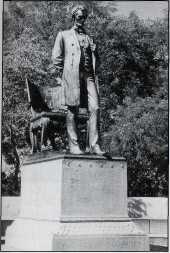 |
Home | Search | Browse | About IPO | Staff | Links |
 |
Home | Search | Browse | About IPO | Staff | Links |
|
The Standing Lincoln Bronze Statue By Augustus Saint-Gaudens, 1847-1907 
Story and photo by Carl Volkmann 
When the famed sculptor Augustus Saint-Gaudens was thirteen years old, two significant events occurred: He abandoned formal schooling to become an apprentice to a cameo cutter; and he saw Abraham Lincoln riding on the train to his inauguration in Washington, D.C. Four years later Saint-Gaudens saw the President Lincoln's body lying in state following his assassination. Augustus Saint-Gaudens was born on March 1, 1847, in Dublin, Ireland, and came to the United States with his family when he was just an infant. During his apprenticeship, he also studied drawing at night. Later he spent four years at the Cooper Union and attended the National Academy of Design. Following this period of apprenticeship and training in this country, Saint-Gaudens went to Paris where he studied at the Ecole des Beaux-Arts and later gained knowledge of the Italian Renaissance while living in Italy. Returning to the United States in 1874, he soon became known as the foremost sculptor in the United States and was a strong influence in the development of American sculpture. In 1881 his statue of Admiral Farragut for Madison Square in New York City set a new standard for public monuments. When Eli Bates, a pioneer in the lumber business in Chicago, died in 1881, his will designated funds to create a fountain and a statue of Abraham Lincoln, both to be erected in Lincoln Park. The trustees responsible for administering these funds conducted a competition
Saint-Gaudens spent several years conceptualizing the statue, which he hoped would be his greatest work. He was the first sculptor to use the life mask of Lincoln and the casts of his hands made by Leonard Volk before Lincoln became president. A Vermont farmer of approximately Lincoln's height served as the model for the statue. The figure of Lincoln portrays the sixteenth president with his left hand clutching at his coat's lapel and his head bowed standing in front of his Chair of State. The chair, which features clawed legs and an American eagle on the back, was inspired by a cast of a seat from a Greek theater. The sculptor wanted the statue to be mounted on a suitable pedestal, and architect Stanford White designed the semicircular bench on which it stands. Several phrases from Lincoln's speeches were inscribed on the base of the monument. The statue was unveiled on October 22, 1887. Chicago Mayor E.A. Roche presided over the event and introduced Thomas Withrow, one of the trustees of the Bates estate. Abraham Lincoln II, the fifteen-year-old grandson of the president, pulled the cord, which released the huge flag that covered the statue. Leonard Swett, longtime colleague and advisor to the president, delivered the dedicatory speech. After praising the president for his greatness, Swett concluded: "And he has made the journey into the great unknown. Before him Washington, Franklin, Hamilton, and Knox had gone. Before him all the great and good men who laid securely and well the broad foundation of this Republic, had fallen before the only foe their valor and courage could not meet. They have all gone! All we know of that great and final journey to the unknown is that our race goes, but none returns." Carl Volkmann of Springfield is the former director of the Lincoln (public) Library in Springfield. Now retired, he is writing a history of Lincoln-inspired sculpture in the state, from which this article, the first of several to be featured in Illinois Heritage, is derived.
ILLINOIS HERITAGE| 9 |
|
|